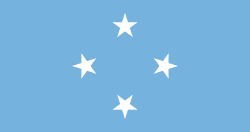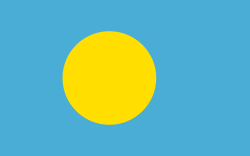Trust Territory of the Pacific Islands
| Trust Territory of the Pacific Islands | ||||||
| United Nations Trust Territory | ||||||
| ||||||
| ||||||
 Location of the Trust Territory of the Pacific Islands in the Pacific. | ||||||
| Capital | Saipan | |||||
| Languages | English (official) Micronesian languages, Marshallese, Chamorro, Palauan | |||||
| Government | Trust Territory | |||||
| Chief of State | ||||||
| - | 1947–1953 (first) | Harry S. Truman | ||||
| - | 1993–1994 (last) | Bill Clintona | ||||
| High Commissioner | ||||||
| - | 1947–1948 (first) | Louis E. Denfeld | ||||
| - | 1981–1987 (last) | Janet J. McCoyb | ||||
| Historical era | Cold War | |||||
| - | Trusteeship | July 18, 1947 | ||||
| - | Free Association | October 1, 1994 | ||||
| Area | ||||||
| - | 1980 | 1,779 km² (687 sq mi) | ||||
| Population | ||||||
| - | 1980 est. | 132,929 | ||||
| Density | 74.7 /km² (193.5 /sq mi) | |||||
| Currency | United States dollar | |||||
| a. | Clinton was President when Palau's Compact of Free Association took effect. Ronald Reagan was President when the RMI, FSM, and CNMI's final status took effect. | |||||
| b. | McCoy retired as High Commissioner in 1987. As Palau was still a part of the TTPI, it was administered by officials in the Office of Territorial and International Affairs until 1994. | |||||

The Trust Territory of the Pacific Islands (TTPI) was a United Nations trust territory in Micronesia (western Pacific) administered by the United States from 1947 to 1986.
History
The territory comprised the former South Pacific Mandate, a League of Nations Mandate administered by Japan and taken by the U.S. in 1944.[1]
The TTPI entered UN trusteeship on July 18, 1947 and was designated a "strategic area" in its 1947 trusteeship agreement. As such, its formal status as a UN trust territory could be terminated only by the Security Council, and not by the General Assembly as with other trust territories. The United States Navy controlled the TTPI from a headquarters in Guam until 1951, when the United States Department of the Interior took over control, administering the territory from a base in Saipan.[2]
A Congress of Micronesia first levied an income tax in 1971. It affected mainly foreigners working at military bases in the region.[3]
On October 21, 1986, the U.S. ended its administration of the Marshall Islands District. The termination of U.S. administration of the Chuuk, Yap, Kosrae, Pohnpei, and the Mariana Islands districts of the TTPI soon followed on November 3, 1986. The Security Council formally ended the trusteeship for the Chuuk, Yap, Kosrae, Pohnpei, Mariana Islands, and Marshall Islands districts on December 22, 1990. On May 25, 1994, the Council ended the trusteeship for the Palau District, after which the U.S. and Palau agreed to establish the latter's independence on October 1.
Current status
The area is now divided into four territories:
Sovereign states in free association with the United States
The following sovereign states have become freely associated with the United States under the Compact of Free Association (COFA).
-
 Republic of the Marshall Islands - Established 1979, COFA effective October 21, 1986
Republic of the Marshall Islands - Established 1979, COFA effective October 21, 1986 -
 Federated States of Micronesia - Established 1979, COFA effective November 3, 1986
Federated States of Micronesia - Established 1979, COFA effective November 3, 1986 -
 Republic of Palau - Established 1981, COFA effect October 1, 1994
Republic of Palau - Established 1981, COFA effect October 1, 1994
Unincorporated organized territory of the United States
-
 Commonwealth of the Northern Mariana Islands - New constitution partially effective January 1, 1978, and fully effective November 4, 1986.[4]
Commonwealth of the Northern Mariana Islands - New constitution partially effective January 1, 1978, and fully effective November 4, 1986.[4]
See also
- High Commissioner of the Trust Territory of the Pacific Islands
- Micronesia portal
References
- ↑ Encyclopædia Britannica: Trust Territory of the Pacific Islands
- ↑ University of Hawaii at Manoa Hamilton Library. "Trust Territory of the Pacific Archives Photos - University of Hawaii". hawaii.edu.
- ↑ Glenn B. Martineau. "Micronesia's Simplified Income Tax System". American Bar Association Journal ,September 1976. p. 1176-1178.
- ↑ "Northern Mariana Islands". CIA World Factbook. Central Intelligence Agency. March 27, 2014. Retrieved April 5, 2014.
External links
![]() Media related to Trust Territory of the Pacific Islands at Wikimedia Commons
Media related to Trust Territory of the Pacific Islands at Wikimedia Commons


